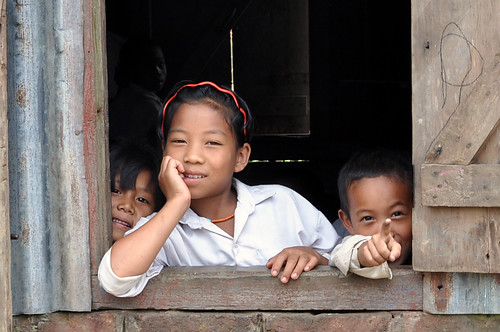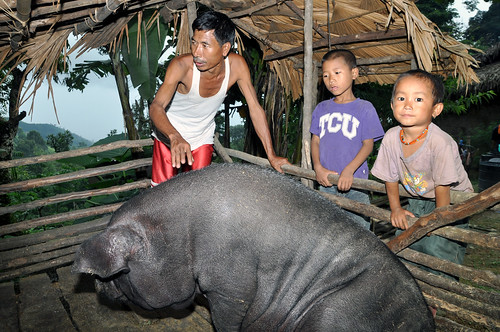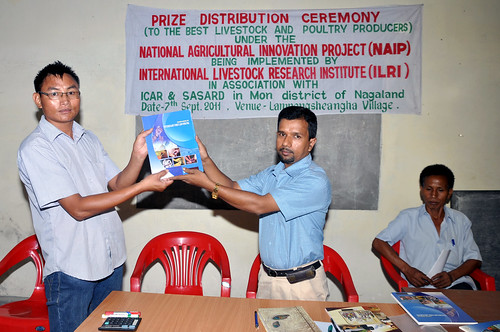Children of a smallholder pig-farming household in Mon District, Nagaland, in the far northeastern corner of (tribal) India, which is participating in an ILRI project to help the rural poor enhance their production of pigs and pork (photo credit: ILRI/Ram Deka).
A new set of training manuals for pig farmers is now available. The manuals inform poor rural pig farmers in developing countries how to ‘intensify’ their production, using lessons gathered from a research-for-development project in India. Among other recommendations, the manuals offer ways of improving smallholder pig farming, including basic veterinary care, and pork production and marketing.
‘These manuals are the result of an analysis of the main gaps in small-scale pig production in India,’ said Rameswar Deka, a scientist from the International Livestock Research Institute (ILRI) based in Guwahati, in northeastern India. ‘They are a response to farmer needs and offer a reference for best practices in managing small-scale pig systems.’
The manuals are a result of a project called ‘Livelihood Improvement and Empowerment of Rural Poor through Sustainable Farming Systems in Northeast India’. The five-year project, in India’s Assam and Nagaland states, was started in 2007 with funding from the Government of India, the International Fund for Agricultural Development (IFAD), ILRI and the World Bank.
Raising pigs is a particularly important livelihood for smallholders in northeast India, where hilly terrain, poor roads and widespread poverty hamper crop cultivation. ‘Crop farming alone cannot meet the needs of families in these areas and many rely on livestock–mostly pigs and chickens–to supply much needed nutrition and income,’ said Deka.
The livelihood improvement project is working with farmers to develop pig production in particular because the region has a history of pig rearing and because keeping pigs requires minimal investments at the outset. Pig production is also easily intensified using locally available resources.
There are three well-illustrated manuals. Smallholders’ pig management offers a detailed look at pig systems in India, including features of common breeds, how to care and manage piglets, the reproductive cycle of pigs, breeding methods and how to cultivate feed-food crops. Veterinary first aid for pig offers information on organisms that cause common pig diseases, how to identify them and basic ways of controlling their spread. Hygienic pork production and marketing details how to hygienically process pork, follow slaughterhouse and meat inspection procedures and how to pack and preserve pork for sale.
ILRI scientist Ram Deka (middle) distributes training manuals to Livestock Service Providers participating in an ILRI pig production project in the state of Nagaland, in northeast India, 2011 (photo credit: ILRI).
The manuals provide easy-to-apply principles in improving pig management, feeding, and care to enhance yields. Farmers in areas where the project is implemented say the manuals are helping them to increase their production. Project staff have set up systems for collecting feedback from farmers and trainers so as to improve future editions of the manuals.
‘We hope these manuals will serve other countries as well,’ said Iain Wright, ILRI’s former representative in Asia. ‘This information can be adapted to make relevant training tools for smallholder pig farmers in other areas of the world where small-scale pig production systems are growing rapidly.’
Download manuals:
Training manual on smallholders’ pig management
https://cgspace.cgiar.org/handle/10568/12533
Training manual on veterinary first aid for pig
https://cgspace.cgiar.org/handle/10568/12534
Training manual on hygienic pork production and marketing




From the Telegraph (Calcutta) comes this news of a disease threat in northeast India (18 Jan 2012)
Livestock disease alert in N-E
‘The region that consumes 50 per cent of the country’s pork is staring at an outbreak of classical swine flu and a host of other dreaded livestock diseases in the coming two months, experts have predicted.
‘The project directorate on animal disease monitoring and surveillance, Bangalore, has warned that four livestock diseases, including haemorrhagic septicaemia, black quarter, foot-and-mouth disease and classical swine fever, will hit the Northeast in February-March. . . .
‘Livestock, especially pig and poultry, is a key livelihood ingredient in the Northeast.
‘A study conducted by the International Livestock Research Institute in 2007 found that there was an increase in demand of livestock products in the region.
‘In Nagaland, the demand for pork has increased from 15 to 25 per cent over the past seven years.
‘It has been estimated that 25 per cent of the pig population in the country is in the Northeast, 80 per cent of indigenous families keep a few pigs (generally two to three) and that the region consumes 50 per cent of the country’s pork, according to Indian Council of Agricultural Research.
‘“Accurate information about the health status of animal population is critical in the fight against livestock diseases and this forms the basis for initiating disease control strategies through optimal utilisation of meagre funds, veterinary resources and manpower,” Rahman said.
‘Prediction, however, is only the beginning of the battle.
‘“A large majority of farmers in Northeast do not get access to good veterinary facilities. If diseases hit the livestock of the farmers, it is a big loss for them,” said Rameshwar Deka, scientific officer at the Northeast office of International Livestock Research Institute in Guwahati.’
Read the whole news clipping here:
http://www.telegraphindia.com/1120119/jsp/frontpage/story_15025299.jsp?utm_source=feedburner&utm_medium=twitter&utm_campaign=Feed%3A+ilrimedia+%28ILRI+in+the+media%29
Good to see such manual. I have downloaded , lets see how it help me to understand and start a piggery farming.
I have gone through the Training manual on smallholders’ pig management.(Not in details just an overview.)
Great its seriousely handy for a new piggery farmer to understand the pig management.
Its gives basics ABCD of piggery farming.
Great and it gives me confidence to take this a new project……..
what an interesting article, I learned a thing or two I never knew about pig farming !
the mannuals are for sure a grate resource for as a beginner in Pig farming as a business.it has empowered me with the basics ineed in the business and i am going to use it maximumly
I’ve downloaded the manuals and it’s very good. I know this will help me a lot and I hope this pig farming venture will grow. Thanks for sharing this post.
Thanx for the manuals. They are very helpful in the piggery sector. As a new person in this industry, I have been so much helped to get to know lots of things about piggery just in a few days og going through the manuals. God bless you for all your efforts invested in these manuals.